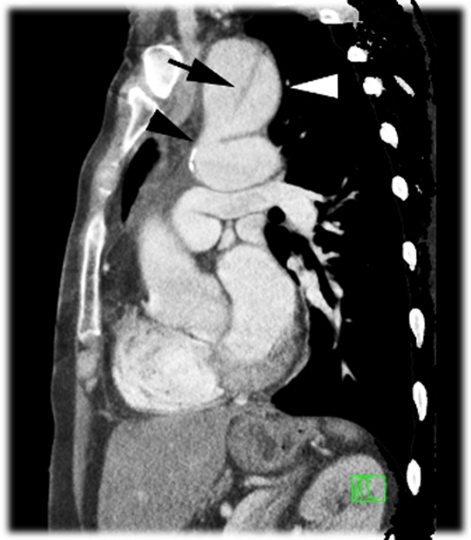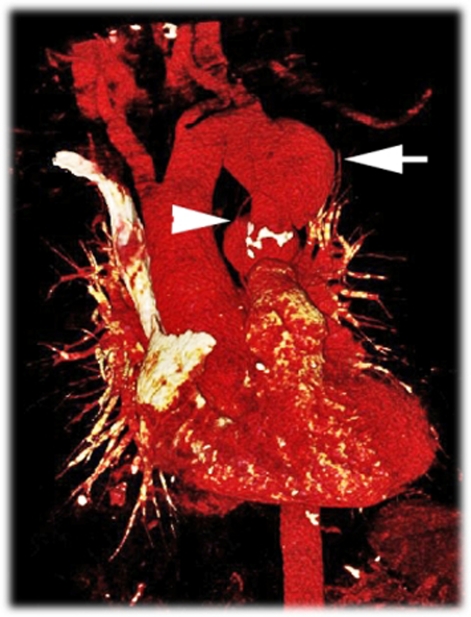Abstract
A 56-year-old woman was admitted to hospital due to stress-dependent hoarseness and hypertensive urgency. The patient reported peaks of blood pressure of 210/160 mm Hg in combination with hoarseness. With indirect mirror examination, the ear-nose-and throat doctor diagnosed a paralysis of the vocal cord on the left side. The authors suspected a mass affecting the vagus nerve and performed a CT-scan with iodinated contrast material of the neck and thorax. Surprisingly the CT-scan showed an aneurysm of the aortic arch with a dilatation up to 4.8 cm, a kinking of 120° and a chronic dissection in the aneurysm. During exercise or elevated blood pressure this aneurysm expanded and made a compression of the nervus laryngeus recurrens on the left side. Thus, there is an explanation for the patient’s hoarseness on exertion and during hypertensive urgency.
Background
Hoarseness is a very common symptom in the emergency department. Therefore, the approach to patients presenting with hoarseness is difficult. Those presentations that do not have a readily identifiable cause present a diagnostic challenge to clinicians, especially in the emergency department.
Case presentation
A 56-year-old woman was admitted to hospital due to stress-dependent hoarseness and hypertensive urgency. The general practitioner diagnosed hypertension 4 weeks earlier and an antihypertensive therapy was initiated with olmesartan (20 mg once a day). The patient reported peaks of blood pressure of 210/160 mm Hg in combination with hoarseness. She did not have chest pain, dyspnoea and no history of autoimmune conditions or other systemic diseases. The patient had mental stress at work and was an active smoker (15 pack years).
Cardiac examination revealed no pathological findings. There was no presence of crackles on examination of the chest, blood pressure was 145/80 mm Hg in both arms. Laboratory tests showed no pathological findings except of slightly elevated p-metanephrin-levels. The echocardiogram and chest x-ray showed no pathological findings.
The patient was referred to an ear-nose-and throat doctor. With indirect mirror examination he diagnosed a paralysis of the vocal cord on the left side. We suspected a mass affecting the vagus nerve and performed a CT-scan with iodinated contrast material of the neck and thorax. Surprisingly the CT-scan showed an aneurysm of the aortic arch with a dilatation up to 4.8 cm, a chronic dissection in the aneurysm (figure 1) and a kinking of 120° (figure 2). During exercise or elevated blood pressure this aneurysm expanded and made a compression of the nervus laryngeus recurrens on the left side. Thus, there is an explanation for the patient’s hoarseness on exertion and during hypertensive urgency.
Figure 1.
CT-scan shows a chronic dissection (1.5 mm) in the aneurysm (black arrow) and a kinking with a functional stenosis (arrowhead) causing an aneurysm of the aortic arch (white arrow).
Figure 2.
CT image reconstruction shows an aneurysm of the aortic arch with a dilatation up to 4.8 cm (arrow) and a kinking of 120° to the lateral side (arrowhead) which caused a compression of the nervus laryngeus recurrens (vagus nerve) on the left side during exercise or elevated blood pressure.
Treatment
An antihypertensive therapy was adjusted with amlodipin and the patient was referred to surgical intervention. During surgery the nerve was prepared, the aneurysm was resected and a short segment interposition of a tube prosthesis was performed.
Outcome and follow-up
Twenty four hours after surgery the patient was discharged from the ICU and 5 days later she was discharged from the hospital. At follow-up visits blood pressure returned to normal and speech therapy improved hoarseness further.
Discussion
Although not a rare entity itself, stress-dependent hoarseness and hypertensive urgency are not often present together. Hoarseness is due to either functional or organic causes. Unilateral paralysis is caused by unilateral recurrent laryngeal nerve injury. The aetiology of unilateral vocal fold paralysis includes iatrogenic injury to the recurrent laryngeal nerve or vagus nerve during procedures in the neck, skull base and chest, extra-laryngeal malignancy of the neck, skull base or thorax invading the recurrent or vagus nerve. Therefore, chest or neck trauma and degenerative neural disorders cause unilateral vocal fold paralysis. Interestingly, approximately one-third are diagnosed as idiopathic, many of which may be of viral aetiology. Sulica reported in their study, that in cases of idiopathic unilateral vocal fold paralysis 40 per cent of patients had a partial or complete voice recovery.1
The incidence of thoracic aneurysm is estimated to be six to ten cases per 100 000 patient years and they mostly occur in the sixth and seventh decade of life.2 3 Patients presenting with thoracic aneurysms are often asymptomatic, depending upon aneurysm location attributed to compression or distortion of adjacent structures there can be chest, flank, or abdominal pain. CT and MRI are the preferred tests to detect a thoracic aneurysm.4–6
In conclusion, the approach to patients presenting with hoarseness is difficult due to the wide differential diagnosis of hoarseness and the fact that hoarseness is often caused by functional disorders. Any patient with persisting hoarseness should be evaluated in order to establish a diagnosis and emergency physicians should think of an aneurysm causing hoarseness especially in older patients with a history of hypertension.
Learning points.
-
▶
Hoarseness is a very common symptom in medicine and in most cases no further investigation is required.
-
▶
The approach to patients presenting with hoarseness is difficult due to the wide differential diagnosis of hoarseness.
-
▶
Physicians should think of an aneurysm causing hoarseness especially in older patients with a history of hypertension.
Footnotes
Competing interests None.
Patient consent Obtained.
References
- 1.Sulica L. The natural history of idiopathic unilateral vocal fold paralysis: evidence and problems. Laryngoscope 2008;118:1303–7 [DOI] [PubMed] [Google Scholar]
- 2.Bickerstaff LK, Pairolero PC, Hollier LH, et al. Thoracic aortic aneurysms: a population-based study. Surgery 1982;92:1103–8 [PubMed] [Google Scholar]
- 3.Conrad MF, Cambria RP. Contemporary management of descending thoracic and thoracoabdominal aortic aneurysms: endovascular versus open. Circulation 2008;117:841–52 [DOI] [PubMed] [Google Scholar]
- 4.Isselbacher EM. Thoracic and abdominal aortic aneurysms. Circulation 2005;111:816–28 [DOI] [PubMed] [Google Scholar]
- 5.Rubin GD. Helical CT angiography of the thoracic aorta. J Thorac Imaging 1997;12:128–49 [DOI] [PubMed] [Google Scholar]
- 6.Roberts DA. Magnetic resonance imaging of thoracic aortic aneurysm and dissection. Semin Roentgenol 2001;36:295–308 [DOI] [PubMed] [Google Scholar]




